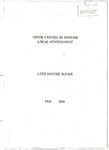Minor Parties In English Local Government
| dc.contributor.supervisor | Thrasher, Michael | |
| dc.contributor.author | Sloan, Luke Samuel | |
| dc.contributor.other | Plymouth Business School | en_US |
| dc.date.accessioned | 2011-01-06T15:31:59Z | |
| dc.date.available | 2011-01-06T15:31:59Z | |
| dc.date.issued | 2010 | |
| dc.identifier | 305432 | en_US |
| dc.identifier.uri | http://hdl.handle.net/10026.1/302 | |
| dc.description.abstract |
This thesis examines the electoral performance of minor parties in English local government from 1973 to 2008, a period that has seen a sharp increase in the numbers of candidates from such parties. Beginning with an overall assessment of the extent to which candidates from minor parties have contested local elections and the level of success in being elected, the thesis then explores the spatial distribution of minor party candidates, the types of people that become candidates and, considering the relative lack of electoral success, their motivations for standing. Traditional studies of party systems frequently exclude parties that do not win a relatively large share of votes and seats or are incapable of forming part of a subsequent government or administration. However broader definitions of what constitutes a party allow that small political parties can influence policy and the behaviour of mainstream parties simply because they are present in an electoral contest. Using the concept of presence, this thesis demonstrates that there has been an unprecedented increase in contestation by minor parties over the past 10 years that has not been proportionally matched by vote share and electoral success. Examination of patterns of contestation reveals that the growth in minor party contestation is uneven across England but is not apparently related to the different electoral systems used by local authorities. Furthermore, it becomes clearer that minor party contestation appears to be primarily a function of temporal local factors and is not necessarily influenced by electoral history, thus making it difficult to predict beforehand where and when such parties may begin to contest local elections and the relative level of electoral support they might subsequently enjoy. Having examined at a general level the electoral nature of minor party activity the thesis offers a new typology, an analytical framework within which to locate the various types of minor parties that feature in modern English local government. Using individual level data we examine whether it is possible to distinguish between candidates based on their party’s location within this typology, thus testing whether the recent increase in minor party activity is due to the rise of a new political class. Initial survey observations subsequently inform the development of a multinomial logistic regression model that seeks to identify similarities and differences between candidates standing for the range of parties currently contesting English local elections. This modelling suggests that candidates from across the range of minor parties are rather similar to each other and, moreover, similar to candidates from major parties. There does not, therefore, appear to be any association between the rise in the frequency of minor party candidates and the existence of a new political class of candidates that are different to those already located within the party political mainstream. Consequently, the value of the typology as a heuristic for establishing a better understanding of minor party activity is brought into question and further research into the phenomenon of minor party contestation in English local government is recommended. | en_US |
| dc.description.sponsorship | ESRC | en_US |
| dc.language.iso | en | en_US |
| dc.publisher | University of Plymouth | en_US |
| dc.subject | Local Government | en_US |
| dc.subject | Elections | en_US |
| dc.subject | Political Parties | en_US |
| dc.subject | Minor Parties | en_US |
| dc.subject | Quantitative Methodology | en_US |
| dc.subject | GIS and Mapping | en_US |
| dc.subject | Logistic Regression | en_US |
| dc.title | Minor Parties In English Local Government | en_US |
| dc.type | Thesis | |
| dc.identifier.doi | http://dx.doi.org/10.24382/1612 | |
| dc.identifier.doi | http://dx.doi.org/10.24382/1612 |
Files in this item
This item appears in the following Collection(s)
-
01 Research Theses Main Collection
Research Theses Main


